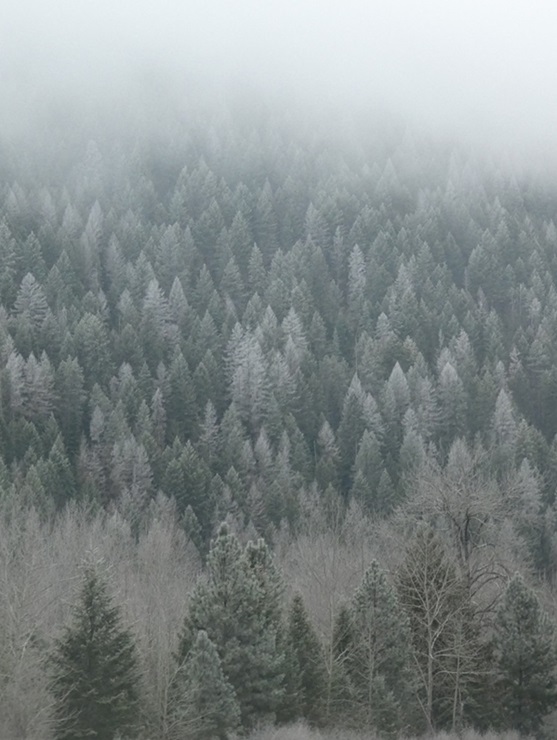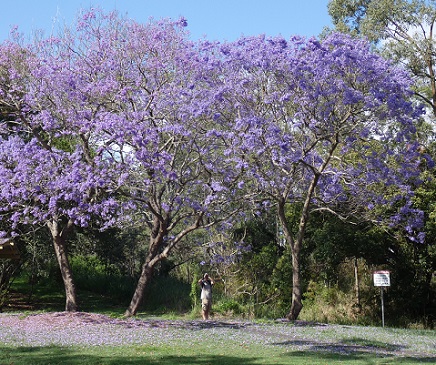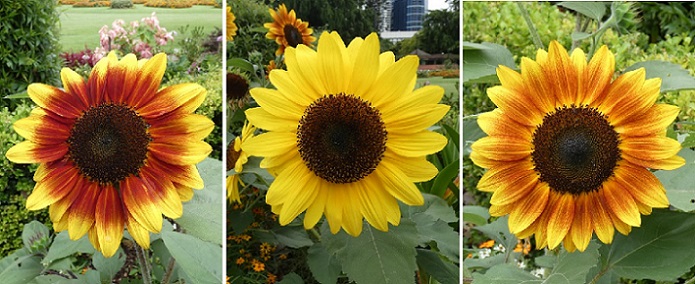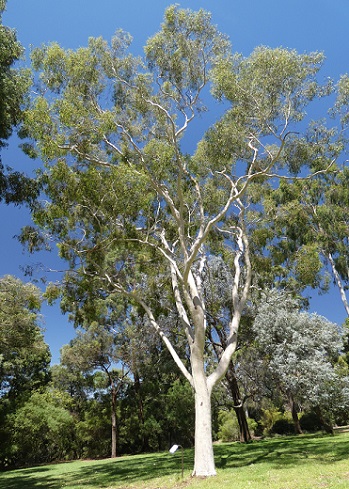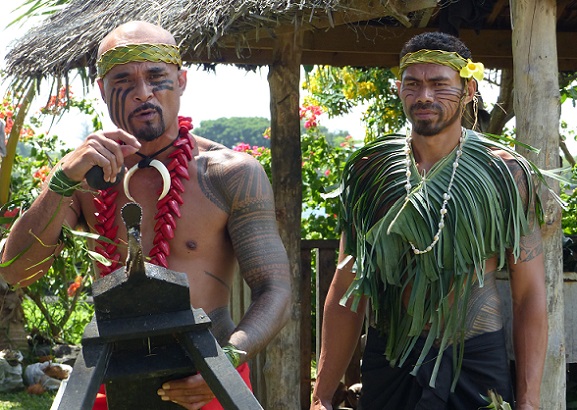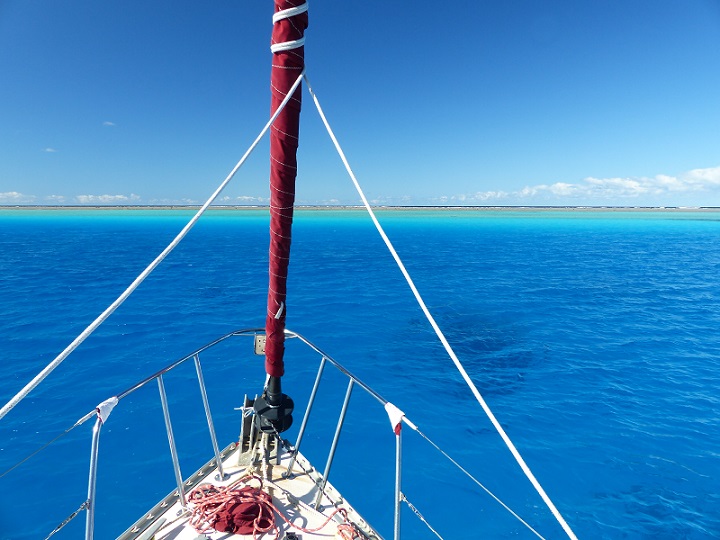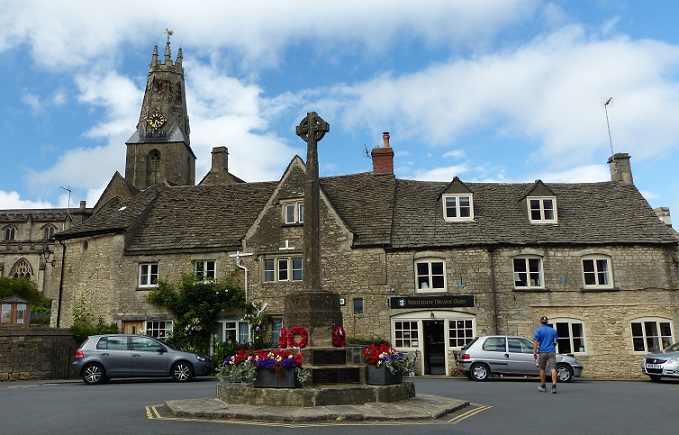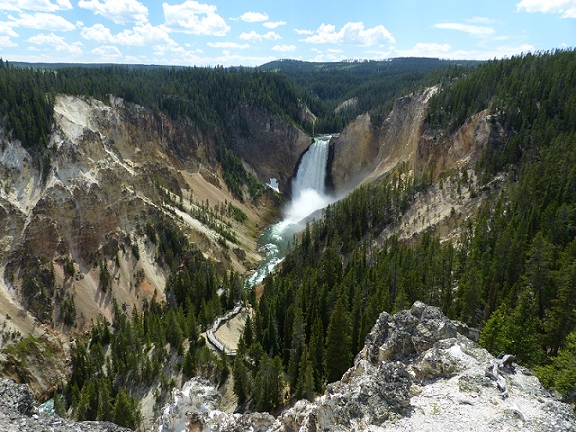
Tregoning
12 April 2024 | We are back aboard Tregoning in Mersin Marina, Mersin, Türkiye
02 April 2024 | We are in Toronto Airport, Canada: Tregoning is in Mersin Marina, Mersin, Türkiye
25 February 2024 | We are back in Gainesville, FL: Tregoning is in Mersin Marina, Mersin, Türkiye
18 February 2024 | We are in Glenwood, New Mexico: Tregoning is in Mersin Marina, Mersin, Türkiye
12 February 2024 | We are in Morro Bay, California: Tregoning is in Mersin Marina, Mersin, Türkiye
19 January 2024 | We are in Vancouver, BC Canada: Tregoning is in Mersin Marina, Mersin, Türkiye
01 January 2024 | We are in Washington State: Tregoning is in Mersin Marina, Mersin, Türkiye
15 December 2023 | We are in Minnesota: Tregoning is in Mersin Marina, Mersin, Türkiye
18 November 2023 | We are in Florida: Tregoning is in Mersin Marina, Mersin, Türkiye
29 October 2023 | We're in Florida - Tregoning is at B-dock, Mersin Marina, Mersin, Türkiye
21 October 2023 | 7 Oda Kapadokya Cave Hotel, Ürgüp, Türkiye
14 October 2023 | Hotel Aşikoğlu, Boğazkale, Türkiye
07 October 2023 | B-dock, Mersin Marina, Mersin, Türkiye
19 September 2023 | “Chez Jon & Angela”, Near Otterton, Devon, UK
14 September 2023 | Airbnb in Fortuneswell on the Isle of Portland, Dorset, UK
11 September 2023 | With Mike, Grange-over-Sands, Cumbria, UK
03 September 2023 | Ardington House, Ardington, Oxfordshire, UK
24 August 2023 | Near "Chez Joan and Peter", College of Roseisle, Moray, Scotland
11 August 2023 | Andrew's house (not exactly), Lichfield, UK
22 July 2023 | Chez Gail, near the New York Café, Budapest, Hungary
Climbing up and diving down
12 October 2020 | Anchored in Trinity Inlet, Cairns, QLD, Australia
Alison Stocker | Photo: Regal angelfish at Flynn Reef
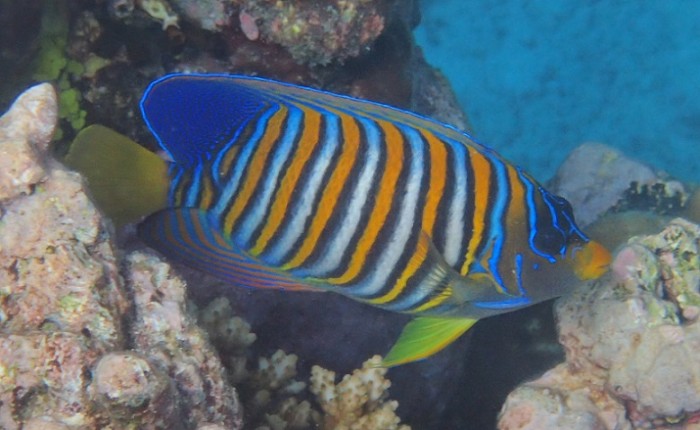
So here we were again in the position of wishing to explore more of the tropics but knowing that we do not want to be caught here in a cyclone. With this being a year for La Niña weather pattern, it is anticipated that it will be an active cyclone season with more, stronger, and earlier storms. The season officially starts on 1st November but there are rarely cyclones that reach Australia that early. Our insurance policy will not cover us for named storms after 1st December unless we are south of the latitude of Mooloolaba which is about 770 nm south of Cairns. So our goal is to reach the south end of Fraser Island (within a day's sail of Mooloolaba) by the end of November.
When we returned from our week of inland travel, the trade-winds were still blowing strongly from the southeast. We would need to be patient and wait for these winds to weaken and turn into northerlies, as was already occurring further south. This change does not necessarily occur further up the coast, which is one of the reasons why we had decided to limit our northward roaming to Cairns.
The dilemma was that these southerly winds were too strong for us to anchor comfortably out on the Great Barrier Reef, especially as we did not know which reefs provide shelter from wind-waves. But if we wait until they abate before going out to the reef, we might feel in a hurry to catch the northerly winds for sailing south and out of the cyclone belt. Thus, I decided to investigate the commercial options for snorkeling on the outer reef.
There are many boats that take snorkelers and divers out of Cairns (maybe 20 or so) and under normal circumstances they would be taking trips out there most days. In the absence of international tourists and most out-of-state visitors, most boats were still running but on a much more limited schedule. To satisfy Covid-19 social-distancing rules, they also had to limit their capacity to about 60%. While this is difficult for the tour companies and their staff, it means that the boats and reef sites will be much less crowded for those of us lucky enough to be able to take advantage of the opportunity to go out to the reef. After a bit of investigation, I chose the Silverswift boat which would take us for three snorkels on the outer reef. Normally I would have picked a mid-week day but given that tours were cancelled that could not get enough passengers, we booked a Saturday trip that was considered most likely to run.
So with that booked, we had a few more things to do in Cairns. We had stayed in the marina for a few days after returning to Tregoning and had been pleased to find SV Kalliope was also there. We had first met Deb and Gregg in Tongatapu in 2017 and we had last seen them in Bundaberg. Deb was booked for a couple of live-aboard dive trips on the reef so she was going to see plenty of it before they sailed south. We had a lovely Greek dinner with them catching-up on our respective travels. They had imported Kalliope into Australia with the intention of selling her here and returning to the US but they were now hesitating in those plans as the US was not as attractive in the midst of the pandemic. Having recently heard that Dina had accepted a job with Médecins Sans Frontières (Doctors Without Borders), she and Malcolm were also planning to sell Good as Gold in Australia. We were starting to feel quite abandoned...
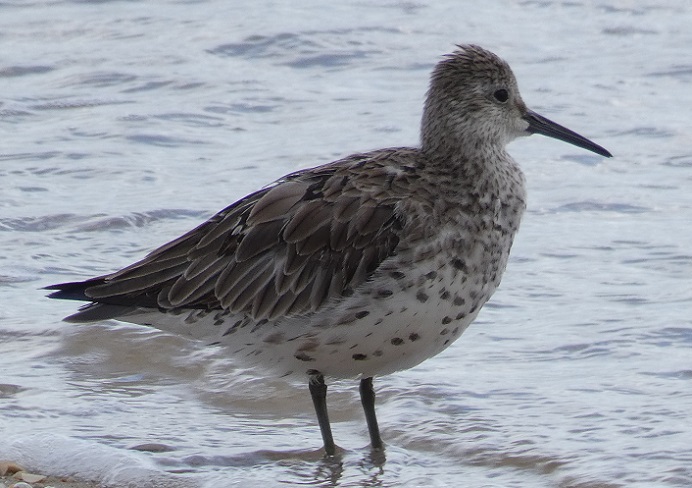
Great knot at Cairns waterfront (to 29 cm or 11 inches)
Oh, well, there was no point in dwelling on these things so we went birding along the city waterfront. We had intended to ride our bikes out to near the airport where there was a boardwalk through the mangroves that was supposed to be good for birdwatching. However, searching for more information online we discovered that it was closed for repairs. I ran out there one morning to confirm this and, other than two bush stone-curlews in the closed car-park, there was nothing else to be seen beyond the screens sealing off the boardwalk.
We arrived at the waterfront about 30 minutes after the ideal time. The tide was coming in, which was good as this concentrates the waders nearer the shore, but it was too high and many of the birds were flying off as quickly as we tried to get a good view of them. Still, there were plenty of pelicans, barred godwits, and two species that were new to us, the cute little black-fronted dotterel (plover) and great knot. This brought the total number of life-list birds for us seen since we arrived in Cairns to 53 species, which was very satisfying.
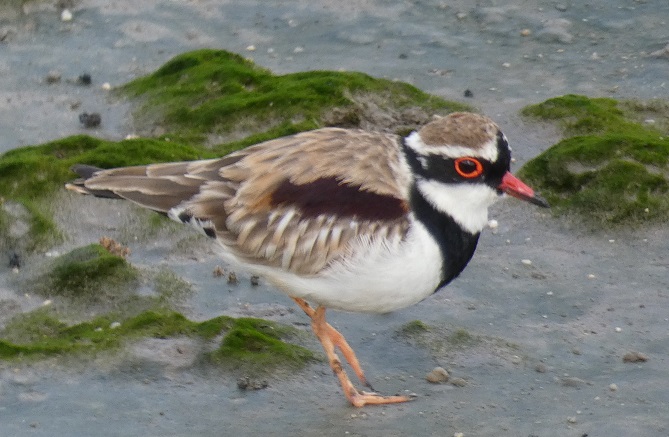
Black-fronted dotterel which looks as though it is wearing a Zorro-type mask (to 18 cm or 7 inches)
After a final burst of laundry, provisioning, filling water-tanks, etc., we left the Marlin Marina early on Saturday morning (3rd October) to avoid having to deal with strong winds. There was space for us to anchor across the shipping channel from the marina, right next to SV Serengeti, but with the wind opposing the tidal current it was difficult to judge where anchors of other boats were. So when the tide changed, we had to move our anchor a little to be well clear of the other moored and anchored boats. Luckily, the anchor held well, despite the fairly strong currents and winds and we were very happy to be so close to Sue and Larry on Serengeti and to the harbour entrance. A dinghy-dock was provided in the marina with access from shore between 6 am and 9 pm. It became pretty crowded during the day but it was very convenient.
We enjoyed various activities with Sue and Larry, including dining ashore and playing music on our boats. Sue very kindly made me a new handbag from old sails to replace the one that I had bought from her in Whangarei and had used daily for about three years. She and Larry also fixed my sewing machine while we were traveling inland, so we were really appreciative of their productive skills.

Another satisfied customer: Alison showing off her new "Serengeti" purse (with the same fish motif from the old one) with SV Serengeti in the background
We also joined them for an afternoon with the "Bad Boys of Uke" in a small bar. Despite the name, this group of four ukulele players and two percussionists actually includes two women. They usually play in larger venues and the audience are encouraged to bring their own ukuleles and play along. In fact, there are two song-books from which they call out the song numbers to help the audience players. Sue and Larry had been to several of these performances (and had one of the books) but the band had not played since the start of the pandemic.
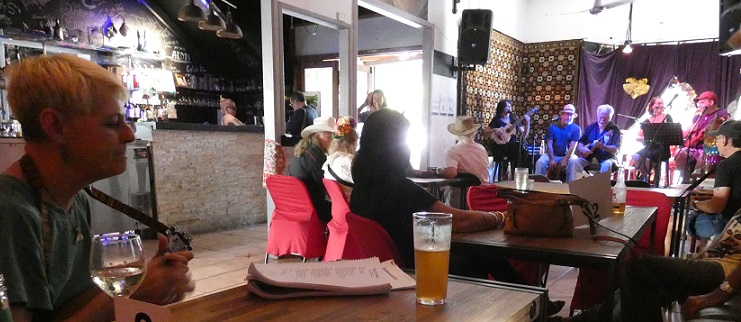
Sue, at left, playing along with the "Bad Boys of Uke"
Seat reservations had to be made for this performance because the number of people was limited by Covid-19 regulations. There was also a sign reminding us that "Dancing is NOT permitted in this venue. We can be fined $6,672. You could be required to leave." It is hard not to dance when standing-up with such lively music so it was best to stay seated. Sue and Larry had loaned Randall a ukulele to play but he was happier just listening while they were strumming along. An additional part-time member of the band played his harmonica for some songs and tap-danced for others. It has been a while since I saw a tap-dancer performing. It was a fun couple of hours and we could see that in bigger venues, pre-pandemic, they must have put on a truly rollicking concert. Perhaps not surprisingly, there was only one audience member who was under 50 years old...
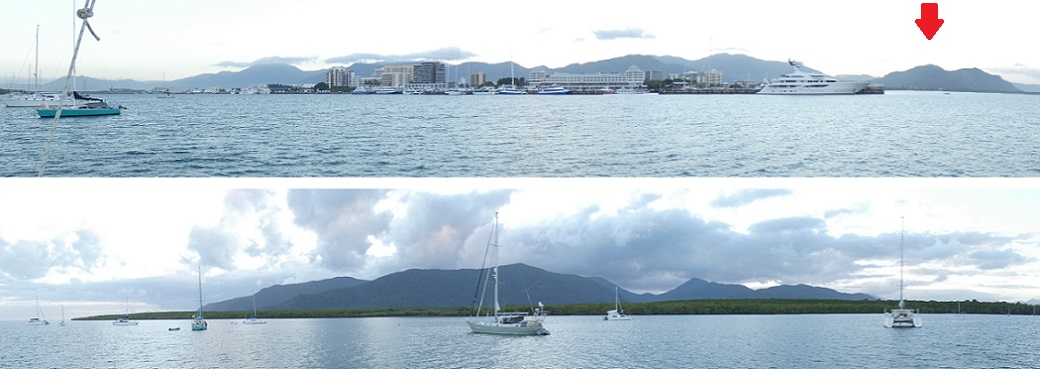
The views from our anchorage in Trinity Inlet: top looking west across the channel to Cairns with Mount Whitfield under the red arrow; bottom view east to SV Serengeti with the hills of Mounts Gorton, Murray, and Yarrabah beyond
One morning, we rode our bikes early to the Cairns Botanic Gardens and set-off on some of the trails up Mount Whitfield. The Red Arrow Walking Track was steep with many steps but was, at least, paved. It was also busy with numerous walkers and runners earnestly exercising. We followed a short section of the Blue Arrow trail to a lookout where we had good views over the runways of Cairns International Airport and across the city to Trinity Inlet.
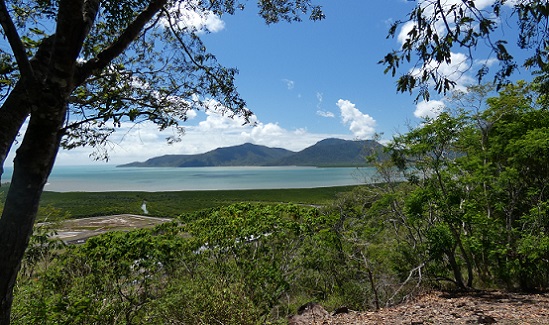
Looking northeast from the lookout on the way up Mount Whitfield with the end of the airport runway to left and Tregoning's anchorage behind the trees on the right
At this point, Randall turned around to spend some time in the Gardens, while I continued up the Blue Arrow trail towards Mount Whitfield. The trail was no longer paved but continued through dense forest with many orange-footed scrubfowl and brush turkeys scrabbling around in the leaf-litter. The loop trail followed the tops of narrow ridges with steep descents and ascents to cross rocky streams. The summit at 364 m (1,194 feet) was actually on the Green Arrow Walking Track so I took that detour from the Blue trail, looking forward to a fine view over the city. Except there was none.

The view from the summit of Mount Whitfield
I am not sure that I have ever climbed a hill to find no view whatsoever from the summit. I was only sure that I was at the peak because the trail started to descend and there was a sign describing the geology of the Whitfield Range as "altered sedimentary rocks and granite intrusions, with the main spine of Mount Whitfield consisting of quartzite." No sign of a view, no sign of the underlying rocks...rather anticlimactic.
Although I had no intention of walking the whole of the Green Arrow Track, which ended in a neighborhood quite distant from the Botanic Gardens, I noticed a tower marked on the map. It was only about 0.5 km from the summit so I thought it might be worth a look. That was 0.5 km of steep descent that I would have to climb on the way back but a small inset on the map showed the view from the Green Arrow trail so it looked as though it would be worth it. Even if it was a tower for a power-transmission line, the cut-through the forest should have a clear view inland and over the city.
Alas, no.
The tower was not a lookout point but was a communications tower, very decidedly not for climbing, and surrounded by tall vegetation.
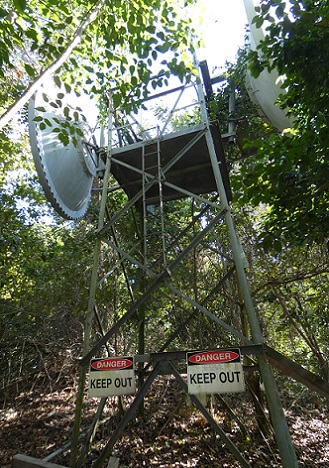
The "Tower" on the Green Arrow Walking Track...my second viewless disappointment
I did not linger but stomped back up to Mount Whitfield and back to rejoin the Blue Arrow loop. A closer look at the map suggested that the very few points on the hills with views were indicated by an icon with someone peering through binoculars and this icon was absent from anywhere on the Green Arrow trail. There was one at the top of Lumley Hill (325 m or 1,066 feet) so I took this short detour from the Blue Arrow trail and was rewarded with a picnic table next to the huts and towers of a major communication hub. The vistas were not wildly exciting, either down the power transmission line or over treetops to the far mountains, but they were, at least, views outside the forest.
Mount Whitfield is so obvious from Cairns that the lack of view over the city was a little frustrating. However, it was a very pleasant trail and even though the hills were not very high, I felt well-exercised with my various detours and in the humid heat. As I pounded along, I mutually startled a couple of red-necked pademelons (small jumparoos) which had apparently been resting in a little cave under a large boulder. They bounded up the hillside and quickly disappeared from view amongst the trees.
I only saw two other people for the couple of hours that I was on the Blue and Green Arrow trails. One of them was apparently leaning his camera to take a picture of something as I approached, so I waited until he had finished. I had assumed it was a pademelon across the stream, but he enthusiastically showed me a well-camouflaged moth on the tree trunk. I would not have noticed it as I hurried by but this chap seemed to be a regular user of this trail and enjoyed looking for the small creatures that most people overlook. I think that he would have been happy to lecture me for hours on his various finds but I eventually thanked him and continued on my way to meet Randall.
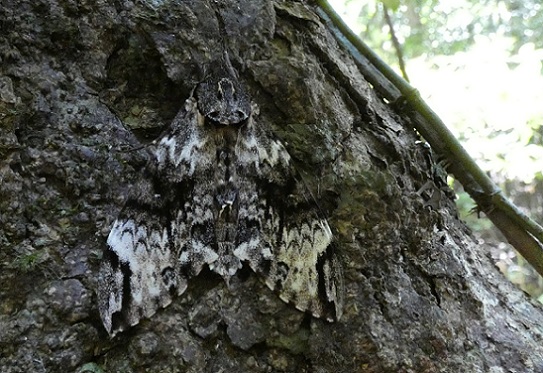
A cryptic moth on a tree trunk
A couple of days later (Saturday 10th October), we packed-up our snorkeling gear and went to check-in for our trip on the Silverswift tour-boat. I had made our reservation by phone and was offered stand-by tickets that were cheaper than the full price of A$234 each. The woman making the booking had not mentioned exactly what "stand-by" meant in this situation, so I was glad that we had not received any message saying that the boat was full so we had been bumped. After chatting about living on a sailboat and being in Cairns for a "little while" (this came up when she asked for a local address), she then offered me the "local" discount. Not wishing to seem rude, I accepted which brought the price for both of us to A$264.60. I was thrilled by this completely unexpected good fortune. There was almost a problem when I went to get our boarding passes and was asked for ID. I whipped out my Florida driver's license and was then asked for something to show that I was local. I explained about living on a boat and, after a long pause, they decided to let it go and gave me the boarding passes.
Confirming that we were making the correct decision not to take Tregoning out to the reef, there was a brisk southeasterly wind. Fortunately, there was not much swell so it was very comfortable as we sped along at 20 to 25 knots on the big power-catamaran. I have wanted to go to snorkeling on the outer edge of the Great Barrier Reef since my 21st birthday (1982), when I had to settle for a trip to the inner reef because there was a problem with the gearbox on the fast-boat that I had booked for a trip to the outside.
Our route took us to Moore Reef briefly because we had to drop a passenger off on the "Reef Habitat" there. This person was the caretaker for the Habitat who would stay for four or five nights. Tour-boats would deliver guests to spend the day at the Habitat, or they could "camp" for the night. We then continued on to Milln and Flynn Reefs on the outer edge of the barrier reef. Out of 19 possible locations on Flynn, Pellowe, Milln, and Thetford Reefs, they chose the day's three sites based on which were optimal for the wind, swell, and tide conditions. We would spend five hours on the outer reefs.

The Reef Habitat at Moore Reef
A day-trip on the Silverswift is a bit more expensive than some of the other boats but not only did we reach the outer reef but it was a relatively new, well-appointed boat, and was not as big as some others. Their usual maximum is 80 passengers but with the Covid-19 restrictions, they are limited to around 60. This trip had 57 people on board, including 10 crew, and independent head-counts were made by the captain and an assistant before leaving each site. Most of the divers appeared to be fairly experienced but there were a few novices who had to watch a training video on the way out to the reefs and who would be escorted by a dive-guide throughout.
The boat was very comfortable with plenty of space (we had a table and four seats to ourselves), good food, and very friendly, knowledgeable staff. We were given useful, clear instructions and on the diving deck, there were separate storage areas for both wet gear and dry towels, etc. Once the boat reached a mooring, most of the dozen or so divers would usually get in the water first, while the rest of us received a briefing about the best snorkeling at the site. After that, we were free to come and go from large back stairs, listening for the loud horn to sound when it was time to return to the boat.
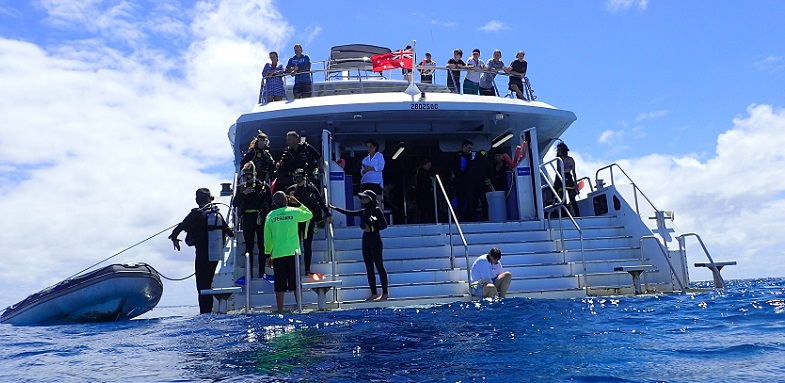
The excellent stairs on the stern of Silverswift seen from the water as a group of novice divers prepare to enter the water with their guides
When it was finally time for the snorkelers to jump in, you might not be surprised to learn that Randall and I were the first. It was absolutely wonderful with clear water over some quite deep coral (maybe 12 m or 40 feet) but with isolated bommies (coral heads) approaching the surface, and shallow reef around the edge of the site.

Randall swimming down towards the bottom in the relatively clear water
Seeing the many large fish that did not mind our presence, it was immediately evident that we were in a Marine National Park, which is a "no-take" area from which fishing, spearfishing, and collecting are prohibited. Several large red snapper were hanging nonchalantly around the top of a bommie along with many mature humpnose bigeye bream, and a pair of diagonal-banded sweetlips.
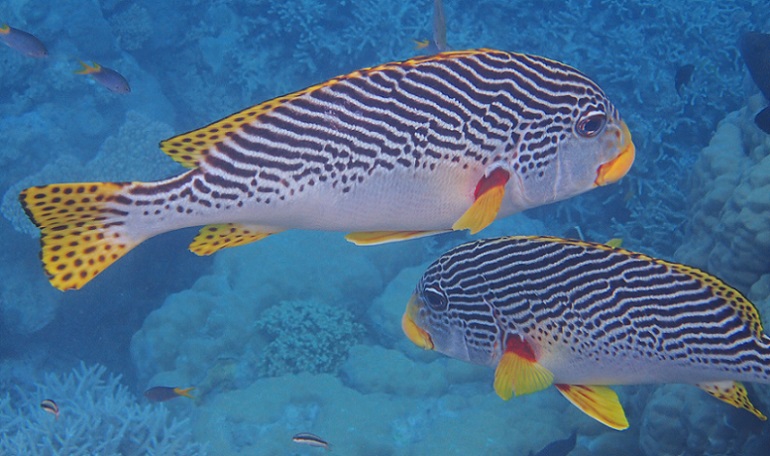
Diagonal banded sweetlips (to 48 cm or 19 inches)
In addition to the clear water and large fish, most of the coral looked healthy and colorful. This was particularly the case for the deeper corals and the coral gardens on top of the deeper bommies. On the shallower reef-flats, there were healthy clumps of coral scattered over larger areas devoid of coral. We could not tell whether the latter areas were the normal result of storm damage or were harmed by high water temperatures and coral bleaching. On this part of the Great Barrier Reef, either is possible so it was important to see the healthier coral at depth.
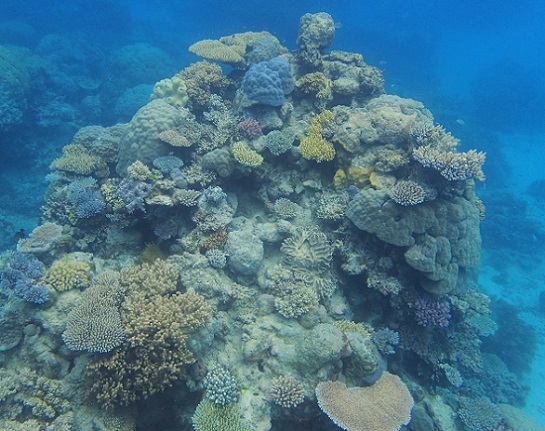
A healthy coral garden on top of a bommie at least 3 m (10 feet) below the surface
I was going to do fish surveys during our snorkels, but once I saw the varied topography of the first site, I decided to swim along with Randall and enjoy the areas while taking photographs. Not being exactly sure how long we would have at each site, I was reluctant to spend half the time with my nose in my underwater fish-lists. By the time we had finished, I estimated that we saw around 150 species, including two that were new to us, a blue demoiselle (a.k.a. blue devil) and blue-spotted ribbontail ray.
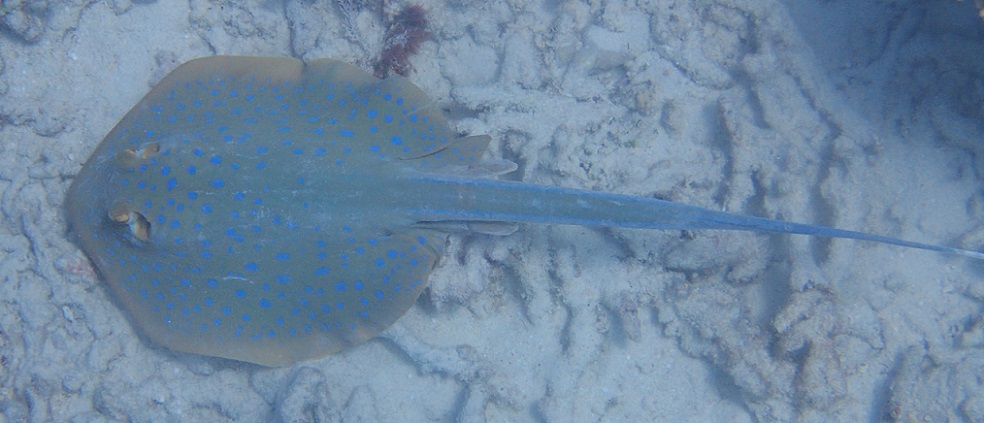
Blue-spotted ribbontail ray (disc to 90 cm or 36 inches across)
Once we moved from Milln Reef, we went to two different sites along Flynn Reef. At the first spot, there was a brief dilemma as we had to decide whether to snorkel before or after lunch. I prefer not to swim with a full stomach but Randall was concerned about missing lunch. Once we saw the long line at the lunch counter, however, Randall was convinced that we should snorkel first. He led the way and made sure that we returned well-before the 1:15 pm closing time at the lunch counter.

A mature spotted (a.k.a. bicolor) parrotfish (to 80 cm or 31 inches) with a seemingly wannabe sixbar wrasse (to 20 cm or 8 inches)
The first site at Flynn Reef had several giant clams that were massive, at least, 1 m (39 inches) wide. It was tempting to get close to them to get a good photograph with Randall in it for scale. However, in the briefing we had been warned that they often close if people get too close, so we stayed away, making sure that others would also have a good view of them while open. Unlike at the other sites, at this one we saw the divers much of the time, but even so, the water never seemed really crowded.
While we ate our lunch and moved to the final site on Flynn Reef, our guide gave a short presentation with photographs about the reef fish. Although little of it was new to us, it was well done and much-appreciated by the audience. He noted that we were likely to see turtles at the last site and some titan triggerfish. The females of the latter fish, will attack divers who get too close to their nests and he had been bitten on the mask by one such irate female. With strong, sharp teeth for snipping-off chunks of coral such nips are not insignificant. Fortunately, it was a little early for nesting season so we were likely to be unmolested. We did not see turtles but we did see some titan triggerfish. We gave them a respectful amount of space.
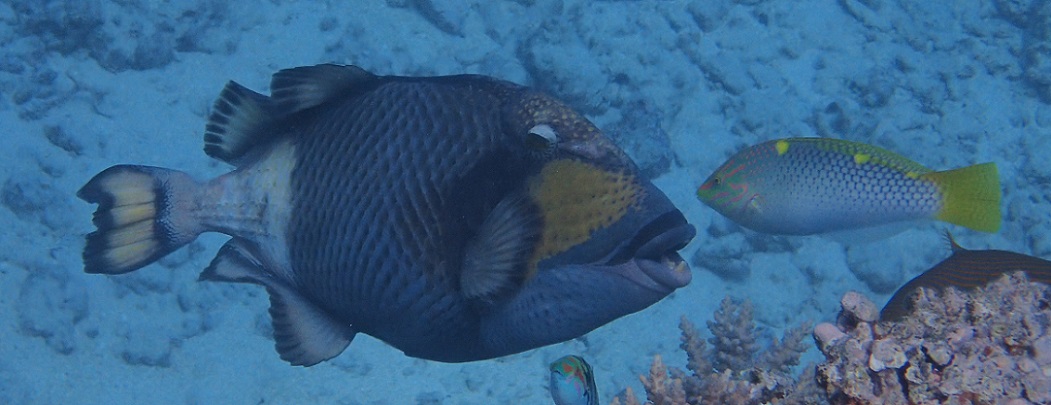
A titan triggerfish (left: to 75 cm or 29 inches) coming face-to-face with a checkerboard wrasse (to 27 cm or 11 inches)
Again, it is probably not a surprise to learn that we were the last snorkelers to get out of the water at the last site. While we had stayed warm enough in our wetsuits and wetskins, at the end of each snorkel it was a great pleasure to be able to soak ourselves and our equipment in the warm water showers on the diving deck. During the 90-minute return passage to Cairns, we ate pieces of the delicious cakes that were provided, and I compiled the list of fish seen. I also raved about what a really great day it had been, especially as we felt as though we got it for a bargain price. Although the pandemic has not been good for the tourist business and the many people unable to travel, for us and the Queenslanders around us, the uncrowded boat and snorkeling conditions were even better than normal.
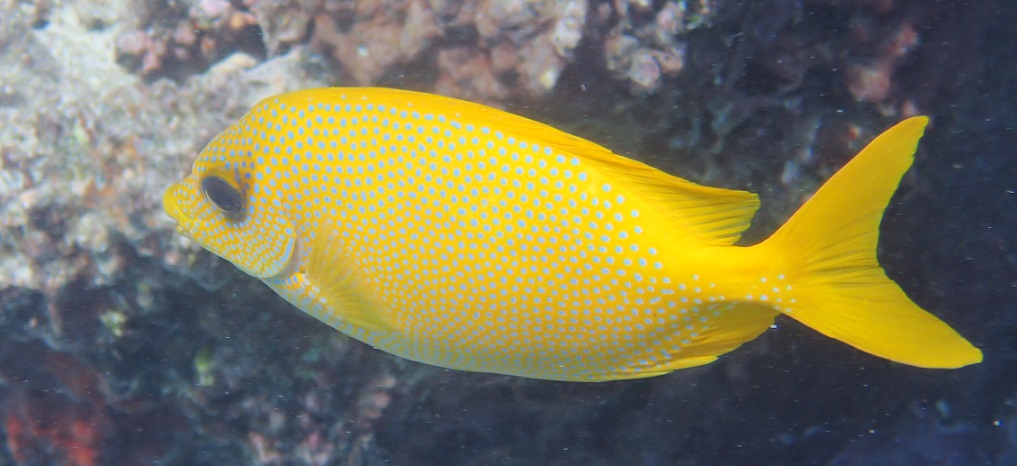
A coral rabbitfish (to 25 cm or 10 inches) with its bright colors glowing in the clear water
Thoroughly inspired to visit more of this northern part of the Great Barrier Reef, we assessed the weather forecasts and decided that within a week the trade-winds should have calmed-down enough to allow us to leave Cairns. Such long-term forecasts often change but we needed to prepare ourselves and Tregoning for our southward migration.
In addition to the usual provisioning, etc., Larry kindly put us in touch with a diver, Bill, who might be willing to clean Tregoning's hull. While the water temperature was much more amenable to this task than it had been in Port Stephens, I was not willing to do this while snorkeling in the muddy water of Trinity Inlet, especially knowing that saltwater crocodiles inhabit the area. We could wait until in clearer water at a reef but that did not seem like an appropriate place for such a job...especially as I would rather be snorkeling for fun.
Bill was from the US but he had married an Australian woman and had spent a long time in Cairns. In the channel, with strong currents, he had to wait for slack tide to do the cleaning. Despite not being able to see much more than a few inches in front of his face, he was confident that it would be safe. He assured us that crocodiles usually swim for longer distances at the surface and none had been seen recently in this part of the Inlet. Still, we looked out for them frequently during the 90 minutes that he was diving under the boat, and we were happy to pay him for completing this tiresome task.
As we made our preparations to depart from Cairns, we received an invitation to join Dina and Malcolm (SV Good as Gold) on a flying trip to Darwin and Kakadu National Park. These are high on our list of priority places to visit in Australia, this would be a good season to go there, and we enjoy the company of Dina and Malcolm. However, we were concerned about adding a significant delay to our southward passage. If we made this inland trip, we would have to forego spending much time on the reef. We would have to sail south as quickly as possible once the north winds appeared and it was hard to imagine being fully relaxed in Darwin as we had to watch the weather patterns in the tropics. We thought long and hard about it but finally had to call back and decline the kind invitation. We have no idea when such an opportunity may come again but in these pandemic-influenced times, we decided to focus on short-term goals rather than worry about long-term travel plans.
When we returned from our week of inland travel, the trade-winds were still blowing strongly from the southeast. We would need to be patient and wait for these winds to weaken and turn into northerlies, as was already occurring further south. This change does not necessarily occur further up the coast, which is one of the reasons why we had decided to limit our northward roaming to Cairns.
The dilemma was that these southerly winds were too strong for us to anchor comfortably out on the Great Barrier Reef, especially as we did not know which reefs provide shelter from wind-waves. But if we wait until they abate before going out to the reef, we might feel in a hurry to catch the northerly winds for sailing south and out of the cyclone belt. Thus, I decided to investigate the commercial options for snorkeling on the outer reef.
There are many boats that take snorkelers and divers out of Cairns (maybe 20 or so) and under normal circumstances they would be taking trips out there most days. In the absence of international tourists and most out-of-state visitors, most boats were still running but on a much more limited schedule. To satisfy Covid-19 social-distancing rules, they also had to limit their capacity to about 60%. While this is difficult for the tour companies and their staff, it means that the boats and reef sites will be much less crowded for those of us lucky enough to be able to take advantage of the opportunity to go out to the reef. After a bit of investigation, I chose the Silverswift boat which would take us for three snorkels on the outer reef. Normally I would have picked a mid-week day but given that tours were cancelled that could not get enough passengers, we booked a Saturday trip that was considered most likely to run.
So with that booked, we had a few more things to do in Cairns. We had stayed in the marina for a few days after returning to Tregoning and had been pleased to find SV Kalliope was also there. We had first met Deb and Gregg in Tongatapu in 2017 and we had last seen them in Bundaberg. Deb was booked for a couple of live-aboard dive trips on the reef so she was going to see plenty of it before they sailed south. We had a lovely Greek dinner with them catching-up on our respective travels. They had imported Kalliope into Australia with the intention of selling her here and returning to the US but they were now hesitating in those plans as the US was not as attractive in the midst of the pandemic. Having recently heard that Dina had accepted a job with Médecins Sans Frontières (Doctors Without Borders), she and Malcolm were also planning to sell Good as Gold in Australia. We were starting to feel quite abandoned...

Great knot at Cairns waterfront (to 29 cm or 11 inches)
Oh, well, there was no point in dwelling on these things so we went birding along the city waterfront. We had intended to ride our bikes out to near the airport where there was a boardwalk through the mangroves that was supposed to be good for birdwatching. However, searching for more information online we discovered that it was closed for repairs. I ran out there one morning to confirm this and, other than two bush stone-curlews in the closed car-park, there was nothing else to be seen beyond the screens sealing off the boardwalk.
We arrived at the waterfront about 30 minutes after the ideal time. The tide was coming in, which was good as this concentrates the waders nearer the shore, but it was too high and many of the birds were flying off as quickly as we tried to get a good view of them. Still, there were plenty of pelicans, barred godwits, and two species that were new to us, the cute little black-fronted dotterel (plover) and great knot. This brought the total number of life-list birds for us seen since we arrived in Cairns to 53 species, which was very satisfying.

Black-fronted dotterel which looks as though it is wearing a Zorro-type mask (to 18 cm or 7 inches)
After a final burst of laundry, provisioning, filling water-tanks, etc., we left the Marlin Marina early on Saturday morning (3rd October) to avoid having to deal with strong winds. There was space for us to anchor across the shipping channel from the marina, right next to SV Serengeti, but with the wind opposing the tidal current it was difficult to judge where anchors of other boats were. So when the tide changed, we had to move our anchor a little to be well clear of the other moored and anchored boats. Luckily, the anchor held well, despite the fairly strong currents and winds and we were very happy to be so close to Sue and Larry on Serengeti and to the harbour entrance. A dinghy-dock was provided in the marina with access from shore between 6 am and 9 pm. It became pretty crowded during the day but it was very convenient.
We enjoyed various activities with Sue and Larry, including dining ashore and playing music on our boats. Sue very kindly made me a new handbag from old sails to replace the one that I had bought from her in Whangarei and had used daily for about three years. She and Larry also fixed my sewing machine while we were traveling inland, so we were really appreciative of their productive skills.

Another satisfied customer: Alison showing off her new "Serengeti" purse (with the same fish motif from the old one) with SV Serengeti in the background
We also joined them for an afternoon with the "Bad Boys of Uke" in a small bar. Despite the name, this group of four ukulele players and two percussionists actually includes two women. They usually play in larger venues and the audience are encouraged to bring their own ukuleles and play along. In fact, there are two song-books from which they call out the song numbers to help the audience players. Sue and Larry had been to several of these performances (and had one of the books) but the band had not played since the start of the pandemic.

Sue, at left, playing along with the "Bad Boys of Uke"
Seat reservations had to be made for this performance because the number of people was limited by Covid-19 regulations. There was also a sign reminding us that "Dancing is NOT permitted in this venue. We can be fined $6,672. You could be required to leave." It is hard not to dance when standing-up with such lively music so it was best to stay seated. Sue and Larry had loaned Randall a ukulele to play but he was happier just listening while they were strumming along. An additional part-time member of the band played his harmonica for some songs and tap-danced for others. It has been a while since I saw a tap-dancer performing. It was a fun couple of hours and we could see that in bigger venues, pre-pandemic, they must have put on a truly rollicking concert. Perhaps not surprisingly, there was only one audience member who was under 50 years old...

The views from our anchorage in Trinity Inlet: top looking west across the channel to Cairns with Mount Whitfield under the red arrow; bottom view east to SV Serengeti with the hills of Mounts Gorton, Murray, and Yarrabah beyond
One morning, we rode our bikes early to the Cairns Botanic Gardens and set-off on some of the trails up Mount Whitfield. The Red Arrow Walking Track was steep with many steps but was, at least, paved. It was also busy with numerous walkers and runners earnestly exercising. We followed a short section of the Blue Arrow trail to a lookout where we had good views over the runways of Cairns International Airport and across the city to Trinity Inlet.

Looking northeast from the lookout on the way up Mount Whitfield with the end of the airport runway to left and Tregoning's anchorage behind the trees on the right
At this point, Randall turned around to spend some time in the Gardens, while I continued up the Blue Arrow trail towards Mount Whitfield. The trail was no longer paved but continued through dense forest with many orange-footed scrubfowl and brush turkeys scrabbling around in the leaf-litter. The loop trail followed the tops of narrow ridges with steep descents and ascents to cross rocky streams. The summit at 364 m (1,194 feet) was actually on the Green Arrow Walking Track so I took that detour from the Blue trail, looking forward to a fine view over the city. Except there was none.

The view from the summit of Mount Whitfield
I am not sure that I have ever climbed a hill to find no view whatsoever from the summit. I was only sure that I was at the peak because the trail started to descend and there was a sign describing the geology of the Whitfield Range as "altered sedimentary rocks and granite intrusions, with the main spine of Mount Whitfield consisting of quartzite." No sign of a view, no sign of the underlying rocks...rather anticlimactic.
Although I had no intention of walking the whole of the Green Arrow Track, which ended in a neighborhood quite distant from the Botanic Gardens, I noticed a tower marked on the map. It was only about 0.5 km from the summit so I thought it might be worth a look. That was 0.5 km of steep descent that I would have to climb on the way back but a small inset on the map showed the view from the Green Arrow trail so it looked as though it would be worth it. Even if it was a tower for a power-transmission line, the cut-through the forest should have a clear view inland and over the city.
Alas, no.
The tower was not a lookout point but was a communications tower, very decidedly not for climbing, and surrounded by tall vegetation.

The "Tower" on the Green Arrow Walking Track...my second viewless disappointment
I did not linger but stomped back up to Mount Whitfield and back to rejoin the Blue Arrow loop. A closer look at the map suggested that the very few points on the hills with views were indicated by an icon with someone peering through binoculars and this icon was absent from anywhere on the Green Arrow trail. There was one at the top of Lumley Hill (325 m or 1,066 feet) so I took this short detour from the Blue Arrow trail and was rewarded with a picnic table next to the huts and towers of a major communication hub. The vistas were not wildly exciting, either down the power transmission line or over treetops to the far mountains, but they were, at least, views outside the forest.
Mount Whitfield is so obvious from Cairns that the lack of view over the city was a little frustrating. However, it was a very pleasant trail and even though the hills were not very high, I felt well-exercised with my various detours and in the humid heat. As I pounded along, I mutually startled a couple of red-necked pademelons (small jumparoos) which had apparently been resting in a little cave under a large boulder. They bounded up the hillside and quickly disappeared from view amongst the trees.
I only saw two other people for the couple of hours that I was on the Blue and Green Arrow trails. One of them was apparently leaning his camera to take a picture of something as I approached, so I waited until he had finished. I had assumed it was a pademelon across the stream, but he enthusiastically showed me a well-camouflaged moth on the tree trunk. I would not have noticed it as I hurried by but this chap seemed to be a regular user of this trail and enjoyed looking for the small creatures that most people overlook. I think that he would have been happy to lecture me for hours on his various finds but I eventually thanked him and continued on my way to meet Randall.

A cryptic moth on a tree trunk
A couple of days later (Saturday 10th October), we packed-up our snorkeling gear and went to check-in for our trip on the Silverswift tour-boat. I had made our reservation by phone and was offered stand-by tickets that were cheaper than the full price of A$234 each. The woman making the booking had not mentioned exactly what "stand-by" meant in this situation, so I was glad that we had not received any message saying that the boat was full so we had been bumped. After chatting about living on a sailboat and being in Cairns for a "little while" (this came up when she asked for a local address), she then offered me the "local" discount. Not wishing to seem rude, I accepted which brought the price for both of us to A$264.60. I was thrilled by this completely unexpected good fortune. There was almost a problem when I went to get our boarding passes and was asked for ID. I whipped out my Florida driver's license and was then asked for something to show that I was local. I explained about living on a boat and, after a long pause, they decided to let it go and gave me the boarding passes.
Confirming that we were making the correct decision not to take Tregoning out to the reef, there was a brisk southeasterly wind. Fortunately, there was not much swell so it was very comfortable as we sped along at 20 to 25 knots on the big power-catamaran. I have wanted to go to snorkeling on the outer edge of the Great Barrier Reef since my 21st birthday (1982), when I had to settle for a trip to the inner reef because there was a problem with the gearbox on the fast-boat that I had booked for a trip to the outside.
Our route took us to Moore Reef briefly because we had to drop a passenger off on the "Reef Habitat" there. This person was the caretaker for the Habitat who would stay for four or five nights. Tour-boats would deliver guests to spend the day at the Habitat, or they could "camp" for the night. We then continued on to Milln and Flynn Reefs on the outer edge of the barrier reef. Out of 19 possible locations on Flynn, Pellowe, Milln, and Thetford Reefs, they chose the day's three sites based on which were optimal for the wind, swell, and tide conditions. We would spend five hours on the outer reefs.

The Reef Habitat at Moore Reef
A day-trip on the Silverswift is a bit more expensive than some of the other boats but not only did we reach the outer reef but it was a relatively new, well-appointed boat, and was not as big as some others. Their usual maximum is 80 passengers but with the Covid-19 restrictions, they are limited to around 60. This trip had 57 people on board, including 10 crew, and independent head-counts were made by the captain and an assistant before leaving each site. Most of the divers appeared to be fairly experienced but there were a few novices who had to watch a training video on the way out to the reefs and who would be escorted by a dive-guide throughout.
The boat was very comfortable with plenty of space (we had a table and four seats to ourselves), good food, and very friendly, knowledgeable staff. We were given useful, clear instructions and on the diving deck, there were separate storage areas for both wet gear and dry towels, etc. Once the boat reached a mooring, most of the dozen or so divers would usually get in the water first, while the rest of us received a briefing about the best snorkeling at the site. After that, we were free to come and go from large back stairs, listening for the loud horn to sound when it was time to return to the boat.

The excellent stairs on the stern of Silverswift seen from the water as a group of novice divers prepare to enter the water with their guides
When it was finally time for the snorkelers to jump in, you might not be surprised to learn that Randall and I were the first. It was absolutely wonderful with clear water over some quite deep coral (maybe 12 m or 40 feet) but with isolated bommies (coral heads) approaching the surface, and shallow reef around the edge of the site.

Randall swimming down towards the bottom in the relatively clear water
Seeing the many large fish that did not mind our presence, it was immediately evident that we were in a Marine National Park, which is a "no-take" area from which fishing, spearfishing, and collecting are prohibited. Several large red snapper were hanging nonchalantly around the top of a bommie along with many mature humpnose bigeye bream, and a pair of diagonal-banded sweetlips.

Diagonal banded sweetlips (to 48 cm or 19 inches)
In addition to the clear water and large fish, most of the coral looked healthy and colorful. This was particularly the case for the deeper corals and the coral gardens on top of the deeper bommies. On the shallower reef-flats, there were healthy clumps of coral scattered over larger areas devoid of coral. We could not tell whether the latter areas were the normal result of storm damage or were harmed by high water temperatures and coral bleaching. On this part of the Great Barrier Reef, either is possible so it was important to see the healthier coral at depth.

A healthy coral garden on top of a bommie at least 3 m (10 feet) below the surface
I was going to do fish surveys during our snorkels, but once I saw the varied topography of the first site, I decided to swim along with Randall and enjoy the areas while taking photographs. Not being exactly sure how long we would have at each site, I was reluctant to spend half the time with my nose in my underwater fish-lists. By the time we had finished, I estimated that we saw around 150 species, including two that were new to us, a blue demoiselle (a.k.a. blue devil) and blue-spotted ribbontail ray.

Blue-spotted ribbontail ray (disc to 90 cm or 36 inches across)
Once we moved from Milln Reef, we went to two different sites along Flynn Reef. At the first spot, there was a brief dilemma as we had to decide whether to snorkel before or after lunch. I prefer not to swim with a full stomach but Randall was concerned about missing lunch. Once we saw the long line at the lunch counter, however, Randall was convinced that we should snorkel first. He led the way and made sure that we returned well-before the 1:15 pm closing time at the lunch counter.

A mature spotted (a.k.a. bicolor) parrotfish (to 80 cm or 31 inches) with a seemingly wannabe sixbar wrasse (to 20 cm or 8 inches)
The first site at Flynn Reef had several giant clams that were massive, at least, 1 m (39 inches) wide. It was tempting to get close to them to get a good photograph with Randall in it for scale. However, in the briefing we had been warned that they often close if people get too close, so we stayed away, making sure that others would also have a good view of them while open. Unlike at the other sites, at this one we saw the divers much of the time, but even so, the water never seemed really crowded.
While we ate our lunch and moved to the final site on Flynn Reef, our guide gave a short presentation with photographs about the reef fish. Although little of it was new to us, it was well done and much-appreciated by the audience. He noted that we were likely to see turtles at the last site and some titan triggerfish. The females of the latter fish, will attack divers who get too close to their nests and he had been bitten on the mask by one such irate female. With strong, sharp teeth for snipping-off chunks of coral such nips are not insignificant. Fortunately, it was a little early for nesting season so we were likely to be unmolested. We did not see turtles but we did see some titan triggerfish. We gave them a respectful amount of space.

A titan triggerfish (left: to 75 cm or 29 inches) coming face-to-face with a checkerboard wrasse (to 27 cm or 11 inches)
Again, it is probably not a surprise to learn that we were the last snorkelers to get out of the water at the last site. While we had stayed warm enough in our wetsuits and wetskins, at the end of each snorkel it was a great pleasure to be able to soak ourselves and our equipment in the warm water showers on the diving deck. During the 90-minute return passage to Cairns, we ate pieces of the delicious cakes that were provided, and I compiled the list of fish seen. I also raved about what a really great day it had been, especially as we felt as though we got it for a bargain price. Although the pandemic has not been good for the tourist business and the many people unable to travel, for us and the Queenslanders around us, the uncrowded boat and snorkeling conditions were even better than normal.

A coral rabbitfish (to 25 cm or 10 inches) with its bright colors glowing in the clear water
Thoroughly inspired to visit more of this northern part of the Great Barrier Reef, we assessed the weather forecasts and decided that within a week the trade-winds should have calmed-down enough to allow us to leave Cairns. Such long-term forecasts often change but we needed to prepare ourselves and Tregoning for our southward migration.
In addition to the usual provisioning, etc., Larry kindly put us in touch with a diver, Bill, who might be willing to clean Tregoning's hull. While the water temperature was much more amenable to this task than it had been in Port Stephens, I was not willing to do this while snorkeling in the muddy water of Trinity Inlet, especially knowing that saltwater crocodiles inhabit the area. We could wait until in clearer water at a reef but that did not seem like an appropriate place for such a job...especially as I would rather be snorkeling for fun.
Bill was from the US but he had married an Australian woman and had spent a long time in Cairns. In the channel, with strong currents, he had to wait for slack tide to do the cleaning. Despite not being able to see much more than a few inches in front of his face, he was confident that it would be safe. He assured us that crocodiles usually swim for longer distances at the surface and none had been seen recently in this part of the Inlet. Still, we looked out for them frequently during the 90 minutes that he was diving under the boat, and we were happy to pay him for completing this tiresome task.
As we made our preparations to depart from Cairns, we received an invitation to join Dina and Malcolm (SV Good as Gold) on a flying trip to Darwin and Kakadu National Park. These are high on our list of priority places to visit in Australia, this would be a good season to go there, and we enjoy the company of Dina and Malcolm. However, we were concerned about adding a significant delay to our southward passage. If we made this inland trip, we would have to forego spending much time on the reef. We would have to sail south as quickly as possible once the north winds appeared and it was hard to imagine being fully relaxed in Darwin as we had to watch the weather patterns in the tropics. We thought long and hard about it but finally had to call back and decline the kind invitation. We have no idea when such an opportunity may come again but in these pandemic-influenced times, we decided to focus on short-term goals rather than worry about long-term travel plans.
Comments
| Vessel Name: | Tregoning |
| Vessel Make/Model: | Morgan Classic 41 |
| Hailing Port: | Gainesville, FL |
| Crew: | Alison and Randall |
| About: | We cast-off from Fernandina Beach in north Florida on 1st June 2008 and we have been cruising on Tregoning ever since. Before buying Tregoning, both of us had been sailing on smaller boats for many years and had worked around boats and water throughout our careers. |
| Extra: | “Tregoning” (rhymes with “belonging”) and is a Cornish word (meaning “homestead of Cohnan” or “farm by the ash trees”) and was Alison's mother’s middle name. Cornwall is in southwest England and is where Alison grew-up. |
Tregoning's Photos - Main
 |
Extra photographs from our three-week campervan tour of the South Island from November 15th to December 5th 2015
217 Photos
Created 4 January 2016
|
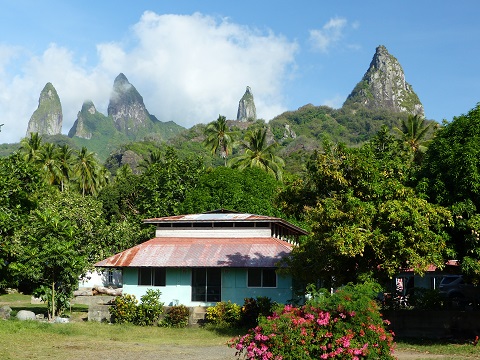 |
Random pictures from our month spent on the islands of Hiva Oa, Tahuata, Ua Pou, and Nuku Hiva
45 Photos
Created 18 July 2015
|
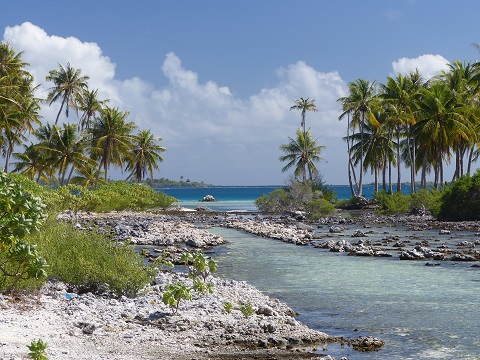 |
Random pictures from our month spent in 4 Tuamotu Atolls; Ahe, Fakarava, Tahanea, and Toau
32 Photos
Created 1 July 2015
|
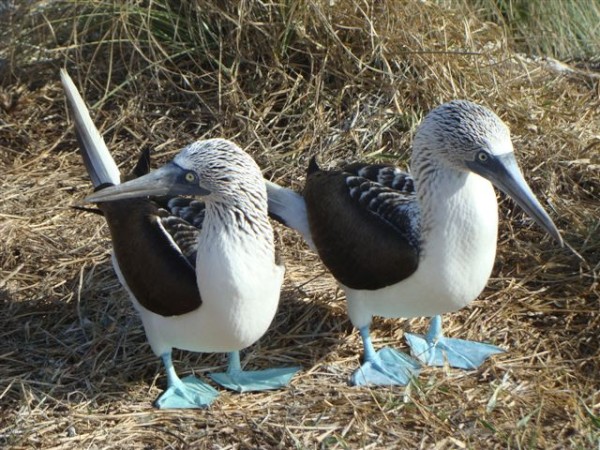 |
Some of the birds, fish, reptiles, and mammals (and others) that we have seen in Mexico
74 Photos
Created 5 May 2014
|
Tregoning

Who: Alison and Randall
Port: Gainesville, FL
